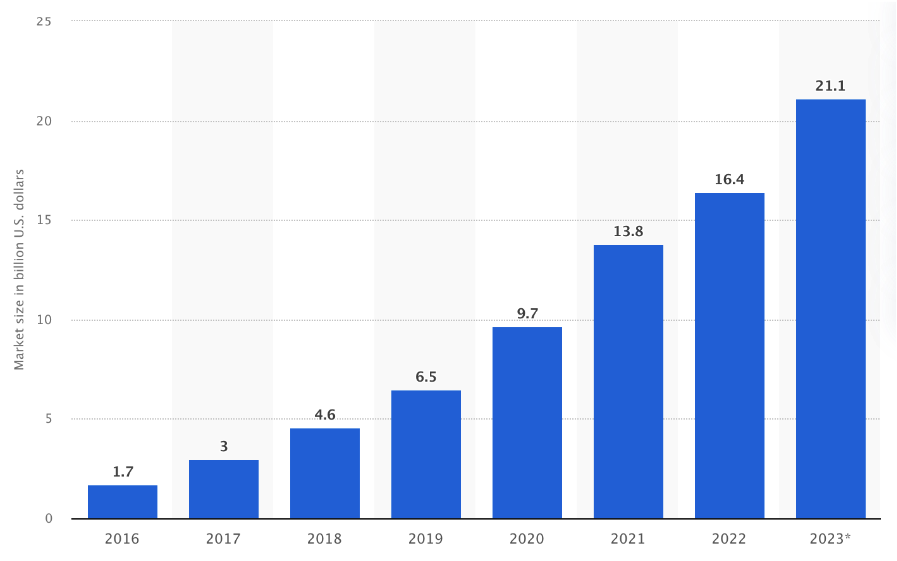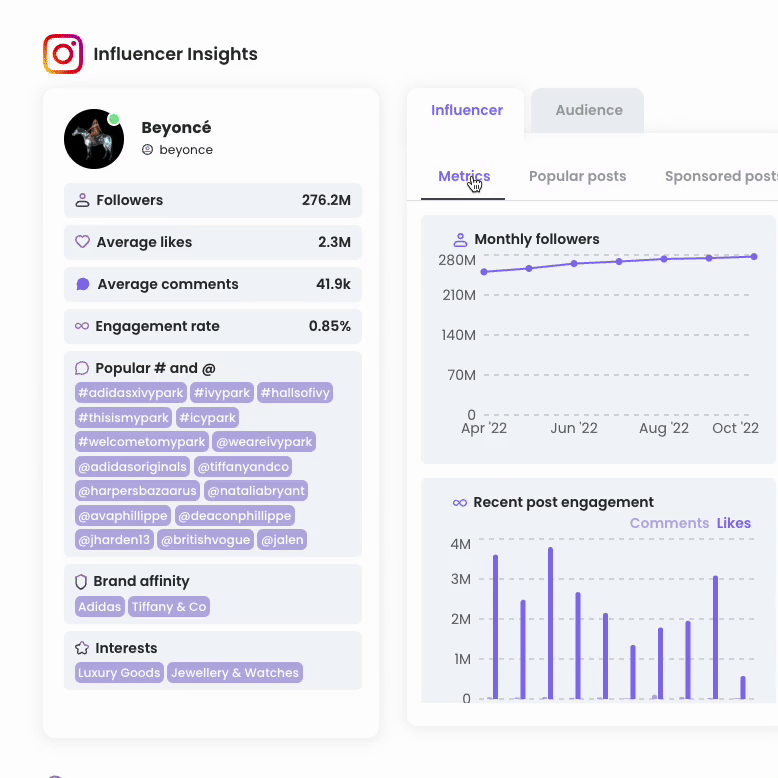Here are 5 influencer marketing statistics that prove its effectiveness! 🔥
🤍 In 3 years, influencer marketing investments have doubled
Global influencer marketing is growing rapidly: the market value is expected to be over 21 billion U.S. dollars this year, having more than doubled since 2020. For a reason: influencer marketing is working.

Influencer marketing market size worldwide from 2016 to 2023 (in billion U.S. dollars)
🤍 93% of marketers have used influencer marketing
This percentage shows that influencer marketing has become essential tool for marketers due to its ability to foster genuine connections with consumers.
With ad-blocking tools and traditional advertising losing impact, influencers offer an alternative way to reach target audiences organically. According to a recent survey, 80% of marketers find influencer marketing effective in driving brand awareness and engagement (Mediakix, “Influencer Marketing 2020 Report”).
Additionally, consumers have become more discerning. They trust recommendations from influencers, who often feel like friends or family members, over traditional advertising methods. This trust translates into increased brand loyalty and higher conversion rates.
Furthermore, influencer marketing allows brands to tap into the power of storytelling. Influencers can create compelling narratives around a product or service, making it more relatable and appealing to their followers. This storytelling approach helps brands establish an emotional connection with their target audience, leading to long-term brand loyalty.
Finally, influencer marketing offers a level of authenticity that traditional advertising struggles to achieve. Influencers are seen as genuine individuals who have built their following based on their expertise, passion, or unique perspective. As a result, their recommendations feel more trustworthy and credible, leading to higher engagement and conversion rates for brands.
🤍 Influencer marketing provides high return on investment
Measuring the impact of traditional media channels such as outdoor media and TV ads can be challenging. Online methods like PPC advertising are more measurable but might not always provide detailed insights into consumer behavior.
Influencer campaigns often provide detailed metrics. Marketers can track engagement, clicks, conversions, and even sales attributed to influencer partnerships, allowing for accurate ROI measurement.
According to Influencer Marketing Hub, businesses earn an average of $5.78 for every $1 spent on influencer marketing. Of course, it depends on the product, target group, and influencer marketing strategy – but this high ROI demonstrates the effectiveness of influencer partnerships in driving brand growth and customer engagement.
🤍 Influencer content has 10x better engagement
Content shared by influencers on social media generates more than 10 times the engagement than content shared directly by brands. People tend to trust influencers, and when influencers authentically promote a product, it can generate high engagement rates, including likes, comments, and shares.
The average engagement rate on Instagram for influencers is around 3.86% – but for smaller influencers, it might be 20% or even 30%. This rate is noticeably higher than the engagement rates of most brands on the platform. Micro-influencers have proven to be highly effective in influencer marketing campaigns, although they have smaller numbers of followers. According to a report by ExpertVoice, 82% of consumers are likely to follow a micro-influencers recommendation.
The content of micro-influencers often feels more authentic and relatable. Their posts are typically less polished and resemble everyday life, making it easier for their audience to connect with the content emotionally, leading to higher trust levels. Not to mention that micro-influencers are usually more budget-friendly compared to macro influencers or celebrities!
🤍 92% of people trust influencer recommendations
Trust is a crucial factor in consumer purchasing decisions. Influencers, with their relatable personalities and expertise in specific niches, have built loyal followings, making their opinions highly influential.
When influencers endorse a product or service, their followers perceive it as a personal recommendation from a trusted friend. This level of trust is rooted in the authenticity and transparency that influencers often maintain in their content. Their genuine experiences and honest reviews create a sense of credibility, guiding consumers in their purchasing decisions.
Influencers maintain high levels of trust and credibility among their audiences. According to Nielsen, 92% of consumers trust recommendations from their favorite influencers over traditional advertisements.
This highlights the power of influencer marketing in shaping consumer behavior and fostering brand loyalty. Businesses recognize the power of influencer marketing, leveraging these authentic connections to establish trust, enhance brand credibility, and reach a broader audience in the digital age.
In conclusion, influencer marketing has proved its effectiveness.
However, manually finding the right influencers, holding negotiations, briefing them, and monitoring their content can be extremely time-consuming – and thus, expensive.
This is why we built Promoty: it’s an all-in-one influencer marketing tool that helps you save time on finding influencers, checking their statistics, monitoring content, and managing influencer relationships. Create a free account to try it out yourself 🤍



